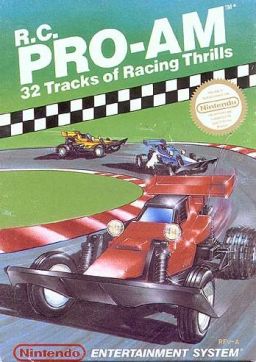
R.C. Pro-Am is a racing video game developed by Rare and published by Nintendo for the Nintendo Entertainment System. It was released in North America in February 1988, and then in Europe on April 15. Presented in an overhead isometric perspective, a single player races a radio-controlled car around a series of tracks in vehicular combat. Each track qualifies its top three racers for the next track. Collectible power-up items improve performance, hazards include rain puddles and oil slicks, and missiles and bombs can temporarily disable opponents. Originally titled Pro Am Racing, it was ported to the Sega Genesis in 1992 as Championship Pro-Am, an enhanced remake with enhanced graphics and additional features. R.C. Pro-Am spawned two sequels: Super R.C. Pro-Am in 1991, and R.C. Pro-Am II in 1992.

Daytona USA is an arcade racing video game developed by Sega AM2 and released by Sega in 1994. Players race stock cars on one of three courses. The first game released on the Sega Model 2 three-dimensional arcade system board, a prototype debuted at Tokyo's Amusement Machine Show in August 1993 and was location tested in Japan the same month, before the complete game released in March 1994. Daytona USA is one of the highest-grossing arcade games of all time.

Stunt Race FX, known in Japan as Wild Trax, is a cartoon-style, 3D-racing video game developed by Nintendo EAD with the assistance of Argonaut Software and published by Nintendo for the Super NES. It was the second game to use the 3D-centric Super FX powered GSU-1.

Top Gear Rally is a 1997 racing video game developed by Boss Game Studios and released for the Nintendo 64. A follow-up to Kemco's original Top Gear game, it features a championship mode where a single player must complete six seasons of two to four races, as well as a multiplayer mode where two players may compete against each other via a split-screen display. The game's tracks combine both road and off-road surfaces and can be played in different weather conditions, including night, fog, rain, and snow. Players may customize their car with different tire grips and adjust its suspension stiffness and steering sensitivity. An option that allows players to custom paint their cars is also included.

Need for Speed II is a racing video game released in 1997 for PlayStation and Microsoft Windows. It is a part of the Need for Speed series and is the second installment, following The Need for Speed.

Formula 1 97 is a racing video game developed by Bizarre Creations and published by Psygnosis for PlayStation and Microsoft Windows. It is the sequel to the 1996 video game Formula 1 and was based on the 1997 Formula One World Championship. This was the last Formula One game to be made by the Bizarre Creations team, who moved on to create the successful Metropolis Street Racer for the Dreamcast and Project Gotham Racing for the Xbox.

Jeep Jamboree: Off Road Adventure is a Game Boy racing video game that involves Jeep Wrangler vehicles. This game was later recycled for use in the video game Race Days.

Road & Track Presents: The Need for Speed is a racing video game developed by EA Canada, originally known as Pioneer Productions, and published by Electronic Arts, released for the 3DO in 1994, and ported to MS-DOS in 1995. Another version of the game, The Need for Speed: Special Edition, was released in 1996 for the Microsoft Windows, PlayStation, and Sega Saturn platforms. The original 3DO version offers eight sports cars, including several exotic models and Japanese imports, and tasks the player with racing in three realistic point-to-point tracks either with or without a computer opponent. Subsequent ports of the game normally include an additional ninth car and have more tracks, including closed circuits. Checkpoints, traffic vehicles, and police pursuits commonly appear in the races.

Ayrton Senna's Super Monaco GP II is an arcade-style Formula One racing video game developed and manufactured by Sega for the Sega Genesis and Mega Drive, Master System, and the Game Gear in 1992. It is a follow-up to Super Monaco GP. The game was also endorsed by, and had technical input from, the then-Formula One champion Ayrton Senna. Gameplay includes a World Championship season featuring recreations of the tracks in the 1991 Formula One World Championship, along with a three-race "Senna GP" mode set on fictional tracks.

Monaco Grand Prix: Racing Simulation 2, also known as just Monaco Grand Prix, is a Formula one racing game developed and published by Ubisoft for Microsoft Windows, Nintendo 64, PlayStation, and Dreamcast. It was released in 1998-1999. A sequel, Racing Simulation 3, was released in 2002.

Test Drive: Off-Road: Wide Open is a racing video game developed by Angel Studios and published by Infogrames for PlayStation 2 and Xbox. It is the first game in the Test Drive series to be developed for the sixth generation of gaming systems, and the fourth and final installment of the Off-Road series. Trucks from General Motors make a full return as playable vehicles after being sort of absent in Test Drive: Off-Road 3.
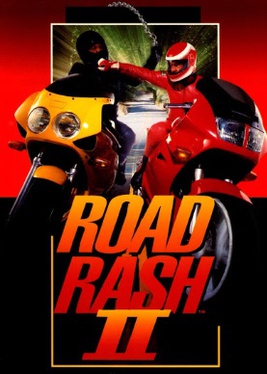
Road Rash II is a 1992 racing and vehicular combat game developed and published by Electronic Arts (EA) for the Sega Genesis. The game is centered around a series of motorcycle races throughout the United States that the player must win to advance to higher-difficulty races, while engaging in unarmed and armed combat to hinder the other racers. It is the second installment in the Road Rash series and introduces a split-screen two-player mode for competing human players, nitrous oxide charges on certain bikes, and chains as offensive weapons.
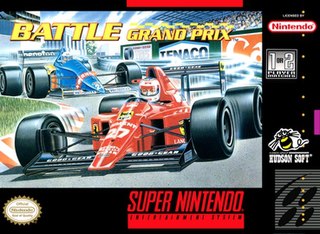
Battle Grand Prix is a 1992 Formula One racing video game developed by KID. One or two players can pit themselves in three Grand Prix races. Each of the different team cars have different color schemes. The courses vary from blacktop to concrete, and rain is also included and is implemented in the game.

2Xtreme is a racing game released for the PlayStation in 1996 and a sequel to ESPN Extreme Games. Unlike the original, the game does not bear ESPN licensing. In it, the player races against others in various events around the world using Rollerblading, skateboarding, biking, and snowboarding. A sequel, 3Xtreme, was released in 1999.

Starwinder is a sci-fi racing video game for the PlayStation. The gameplay involves obtaining power ups and slowing down opponents, in order to reach the finish line first, similar to that of the Wipeout series. There are 10 sectors containing 5 tracks each, with a total of 40 race tracks. There are 7 usable ships, with every track competed by the player unlocking a new ship. Unlike most racing games, the player can steer off the course away from the track at the cost of lowered speed.

Moto Racer Advance is a motocross racing game developed by Adeline Software International, produced by Delphine Software International and published by Ubisoft for the Game Boy Advance. It was released in 2002 in PAL regions on October 4 and in North America on December 4. It is part of the Moto Racer series and was the last game to be developed by Adeline Software and also the last with any involvement from Delphine Software.
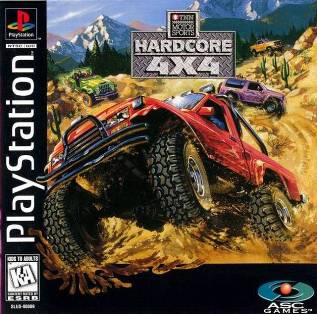
Hardcore 4x4 is a racing video game developed by Gremlin Interactive for the Sega Saturn, PlayStation and Microsoft Windows. It became available for download from PlayStation Store as a PSone Classic for play on the PlayStation 3 on January 10, 2008, in PAL regions. The game utilizes 3D environments and truck models. The soundtrack features hard rock music.
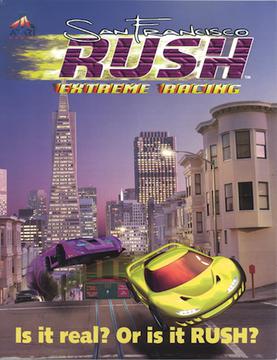
San Francisco Rush: Extreme Racing is a video game developed and published by Atari Games. This game was first released in arcades in 1996 and was ported to Nintendo 64 in 1997 and the PlayStation in 1998. San Francisco Rush: Extreme Racing is the first game in the Rush series.

Road Rash is a 1991 racing and vehicular combat video game originally developed and published by Electronic Arts (EA) for the Sega Genesis. It was subsequently ported to a variety of contemporary systems by differing companies. The game is centered around a series of motorcycle races throughout California that the player must win to advance to higher-difficulty races, while engaging in unarmed and armed combat to hinder the other racers.
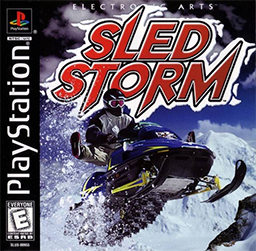
Sled Storm is a snowmobile racing video game published and developed by Electronic Arts. It gained critical acclaim due to its original concept of being one of the first snowmobile racing titles.




















